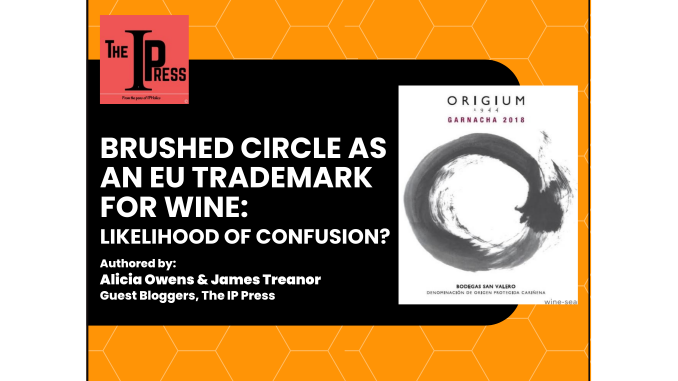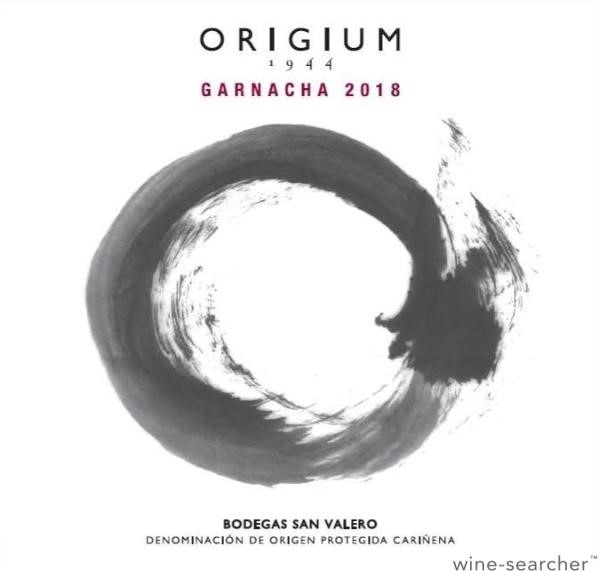
The proprietor of the earlier national trademark prevailed in a trademark dispute involving a brushed circle as an EU trademark for wine. Despite the earlier mark’s word element ORIGIUM 1944 and different colouration, the CFI determined that there was a high likelihood of confusion.
A word/figurative mark, such as the earlier national mark ORIGIUM 1944, has a weaker scope of protection than an identical wordmark. Because a figurative mark is protected in the same way that it was applied for, all elements, i.e., the combination of the word element and the figurative representation, are considered when comparing marks.
However, in this case, the word/figurative mark was asserted against a pure figurative mark with no word element. The focus was thus on whether the earlier mark’s word element ORIGIUM 1944 was to be considered distinctive.

Facts of the case: Union marks Brushed circle
The applicant, 1031023 B.C. Ltd (Canada), applied for a yellow brushed circle as a Union figurative mark in April 2018. Following that, the intervener, Bodegas San Valero, S. Coop. (Spain), filed an opposition to this trademark registration in July 2018. It alluded to its earlier national figurative mark ORIGIUM 1944, which depicts a black brushed circle. The disputed mark was registered for the Nice Class 33 product “wine,” while the earlier national mark ORIGIUM 1944 was registered for Nice Class 33 “alcoholic beverages, except beers.”
Was there therefore a likelihood of confusion, as the intervener claimed? Because of their many similarities, the Board of Appeal determined that there was a high risk of confusion. The applicant appealed this decision to the European Court of Justice (CFI), which issued its decision on the matter on January 12, 2022 (T-366/20).
Are the results of a search in the “TM View” database admissible evidence?
The Board of Appeal found co-dominance of the figurative and word elements of the earlier mark when comparing the similarities of the two figurative marks. Several annexes to the application were intended to demonstrate, in particular, that Spanish consumers understand Latin words. If this is proven, the earlier mark’s verbal elements may be considered more dominant.
An article on the lexicon of the Spanish language and a ministerial decree of the Spanish government on the compulsory content of the “Baccalauréat,” which grants access to university, were submitted as annexes. The CFI, however, refused to accept these annexes because they were not available at the time of the Board of Appeal’s decision and thus constituted new evidence.
The CFI, on the other hand, made a different decision on another annexe to the application, namely the reference to the results of a search in the EUIPO’s “TM View” database. Even though these results were submitted for the first time before the CFI, they were accepted as admissible. The CFI explained that the results of a search in the EUIPO’s “TM View” database are not evidence in the strict sense, particularly under Article 85 of the General Court’s Rules of Procedure. Rather, they concern EUIPO’s registration practice, to which a party to proceedings may refer (see July 2019 CFI judgment, Gruppo Armonie v EUIPO (mo. da), T-264/18).
Is this, however, decisive for the assessment in this case? In a nutshell, no.
The use of a foundation date on wine labels is common.
The Board of Appeal determined that the main difference between the conflicting signs was the absence of a word element in the mark applied for, but that this difference did not eliminate the signs’ similarity.
This decision was confirmed by the CFI. Even if a portion of the Spanish-speaking public in the European Union perceives “Origium” as “origin” and the word combination “Origium 1944” as information on the winery’s founding date, the CFI stated that such a consideration does not make this element dominant or distinctive. In the wine industry, it is quite common to indicate the founding date of their winery on the labels of wine bottles; in this regard, “Origium 1944” could be seen as purely descriptive and thus weak or even very weakly distinctive. As a result, the possibility of it being a dominant element is almost ruled out.
However, the court explained that only if all other elements of a mark are negligible can the assessment of similarity be based solely on the dominant element. This was not the case in this instance.
ORIGIUM brushed circle – with and without 1944
In any case, when examining the likelihood of confusion, trademarks must be compared as a whole – which, according to the CFI, does not rule out the possibility that one or more elements of a composite trademark may be decisive for the overall impression created by the trademark in the minds of the relevant public. The overall impression in this case, however, was characterized by the brush-like design of the figurative elements, which were both drawn in similarly sized brushed circles.
The applicant argued in vain that the different colour designs should have been considered distinguishing features.
The earlier mark is black and white – and it was registered without any colour claim. The applied-for mark, on the other hand, is a gold and grey combination. However, the CFI ruled that the colour differences were not particularly significant in the overall impression, as the features due to the brushed circle of both marks predominated. Colour variations may be perceived by customers.
In any case, a phonetic comparison of a purely figurative mark with a figurative mark containing a word element is not possible, according to the CFI.
Spain – the land of great wine lovers.
Furthermore, the CFI stated that wines are intended for the general public, who are also deemed to be normally informed, reasonably observant, and circumspect, according to established case law. As a result, an average level of attention should be assumed.
The plaintiff argued in vain that because Spain is known for its gastronomy, particularly its wines, Spanish consumers are great wine lovers with a correspondingly high level of attention. This argument was rejected by the CFI. The fact that the average consumer will inspect the various elements on the label of a bottle of wine when purchasing this type of product does not imply that his level of attention is particularly high. When purchasing a bottle of wine, the consumer will focus on the various characteristics of the wine rather than the trademark, the CFI ruled, citing a related 2011 CFI decision, [ROSALIA DE CASTRO], T-421/10.
Finally, the CFI determined that signs have a medium degree of visual similarity and are identical, or at least highly similar, conceptually.
As a result, the Board of Appeal was entirely correct in concluding that there was a high likelihood of confusion between the signs. The action was dismissed in its entirety, and the Board of Appeal’s contested decision was upheld.
Alicia Owens
Author
Alicia Owens is the Managing partner of Brealant. Alicia has a significant Transactional experience in the Broad Range of Trademark, Copyright, and Patent. She is also a seasoned legal marketing consultant with more than a decade of experience in strategic marketing initiatives.

James Treanor
Author
James Treanor is an Intellectual Property expert, and a graduate of the University of California. Founder of Brealant an IP Firm in the Philippines. Brealant is an accomplished IP services firm that focuses on intellectual property, with expertise in trademark and patent registration. The services they offer since its founding in 2002 have helped companies and individuals with the registration and management of all aspects of Intellectual Property
Leave a Reply